Ghost towns
A ghost town is a place where physical evidence remains to mark the site of a once-active human settlement which has been abandoned, leaving few or no inhabitants.

A few are archaeological sites where settlement existed in the distant historic past or are part of exclusion zones due to man-made or natural disasters. More commonly, ghost towns quietly appear when the reason for the town's creation no longer exists. A mining town is abandoned once too little ore remains to be profitable, a railway town is abandoned once the train no longer stops, a manufacturing town is abandoned when its last factory closes. Occasionally a village can avoid becoming a ghost town by finding a new vocation to replace a dying industry, but this becomes substantially more difficult if the town site is far off the beaten path.
While some ghost towns have been partially restored and commercialised as tourist traps, many more are in remote or awkward locations where the abandoned buildings are left to be slowly reclaimed by the elements. While legal consequences for trespassing are improbable in many of these locations, the leave-no-trace principle remains vital so that subsequent travellers may view these sites without key pieces being damaged, removed or buried in rubbish.
Once no physical evidence remains, a settlement is typically removed from lists of ghost towns. Examples would include towns entirely flooded by hydroelectric development or wilfully demolished, if no traces remain of the former village.
Natural disasters
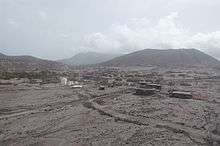
- Craco, Italy was abandoned in 1963 due to landslides and today is used as a cinematic filming location.
- Pompeii and Herculaneum, destroyed by volcanic activity, now archaeological sites.
- Plymouth (Montserrat), nominally capital of Montserrat but inaccessible and buried under volcanic ash since 1996.
- Brigham City, near Winslow (Arizona) USA, was an 1876 Mormon town abandoned in 1881 due to flash flooding; 37 buildings have been partially restored.
- Saint-Jean-Vianney, Shipshaw (Québec), built on unstable Leda clay, was abandoned after a May 4, 1971 landslide swallowed 38 homes, killing 31. Its remaining homes were physically relocated to Arvida, leaving little at the site except a crater, a stone monument and some damaged road. In 1989-91, tiny Lemieux (Ontario) abandoned its Leda clay town site to avoid a similar fate, leaving behind just a marker and a local graveyard.
- The original town of Poggioreale (nowadays known as Poggioreale Vecchia, Old Poggioreale) in the Trapani province in western Sicily was largely destroyed in the 1968 Belice earthquake. After the quake, a new Poggioreale was built at a location supposedly safer from future earthquakes about 4 km to the south, leaving the old one as a ghost town. Similarly, many other towns in the Belice Valley including Gibellina, Vita, Santa Margherita di Belice and Salaparuta were rebuilt at locations some distance away from the original towns.
Man-made disaster
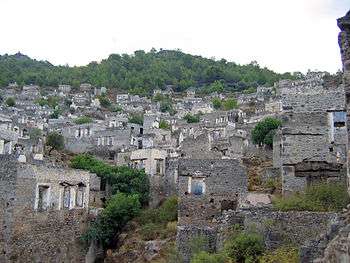
Environmental
- Centralia (Pennsylvania), USA - demolished due to an underground mine fire, which was ignited in 1962 and has been burning ever since. As of 2012, eight residents and many empty streets remain.
- Picher (Oklahoma), USA - lead-mining towns Picher, Treece and Cardin were already in the process of being abandoned due to lead contamination and mine shafts undermining the town site when an EF4 tornado swept in 2008, leaving a mile-wide swath of devastation which was never repaired. Many or most buildings have now been demolished; the last operating business, Gary Linderman's Old Miner's Pharmacy, closed in 2015.
- Times Beach near St. Louis (Missouri) USA - demolished due to dioxin contamination and flooding, now Route 66 State Park. One building remains as the park's visitor center, but is cut off from the rest of the park as the Route 66 highway bridge has deteriorated beyond use.
- Wittenoom, Pilbara, Western Australia - Former asbestos mining town, contaminated with crocidolite asbestos dust and abandoned decades after the mine closed.
Nuclear
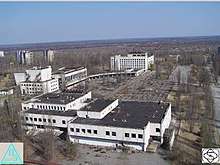
- Namie (浪江町), Futaba (双葉町) and Ōkuma (大熊町), towns in Fukushima (prefecture), Japan - in exclusion zone due to tsunami-damaged Fukushima Daiichi nuclear reactors. Local buildings damaged by the 2011 earthquake were never repaired.
- Pripyat (Chornobyl Oblast), Ukraine - abandoned due to April 26, 1986 nuclear reactor fire and radioactive contamination, five years before the fall of the Soviet Union. Visits are by guided tours only, and unsurprisingly there are strict rules concerning radiation hygiene.
War and forced relocation

- Ani, near Turkey-Armenia border. — Was part of Armenia until an Ottoman Turkish invasion (sometime after the 1917 Russian Revolution) drove out the local Armenian population. Now uninhabited, but popular among travellers to Kars.
- Kayaköy, near Fethiye in Lycia, Turkey. — Under the Treaty of Lausanne, a group of Muslim farmers was forced to relocate to this mountain village from Greek Macedonia. For want of flat land for agriculture, many left; due to a 1957 earthquake and decades of neglect, this place is now partially abandoned.
- Oradour-sur-Glane, near Limoges, France. — An entire village massacred and burned by the Gestapo during World War II; the ruins of the town have been left undisturbed and a museum constructed nearby.
- Nineveh, opposite Mosul, Iraq on Tigris River. — Extant since Biblical times; the capital of a Neo-Assyrian Empire which began to unravel due to civil war after the 627 BC death of king Ashurbanipal. Sacked by the Babylonians, Chaldeans, Medes, Persians, Scythians and Cimmerians in 612 BC and razed to the ground. An archaeological site since 1842 and occasional target of reconstruction attempts, it has apparently been destroyed by the so-called "Islamic State," though the full extent of the damage is hard to verify.
- Varosha, near Famagusta, Cyprus. — The population of this now-abandoned seaside resort was forced out during the August 1974 Turkish occupation of Northern Cyprus. While the UN will not allow the Turks to colonize Varosha for themselves, armed Turkish soldiers stubbornly keep all others out of the now-crumbling village and interfere with photographers' efforts to document the situation.
- Little remains of Billmuthausen (founded 1340, demolished 1978) in southern Thuringia, East Germany. Destroyed by Communist authorities because of its proximity to the "Iron Curtain" border, just a village cemetery, an electrical transformer hut and the village well remain. A church was rebuilt and a memorial constructed after the end of the cold war. Many Eastern villages within 5 km (3.1 mi) of the border fared worse; all that remains of Bardowiek, northwest Mecklenburg is an electrical transformer building and some hamlets are gone with no trace at all.
- Agdam in Nagorno-Karabakh (an unrecognised state on the Azerbaijan-Armenia border) was a busy town until the Nagorno-Karabakh war and the battle which ruined the city in July 1993. Today it is deserted.
- Nicosia airport was the main airport of Cyprus until the Turkish invasion in 1974. It's in the UN buffer zone between Northern Cyprus and the Republic of Cyprus, the airport is not used for commercial operations any longer, but functions as the headquarters for the UN peacekeeping force. Most buildings including the main terminal (just used for six years when the airport was closed) plus a Cyprus Airways jet on the runway are withering away.
- Bokor Hill Station, Cambodia. — Founded by the French colonialists high up the mountains in the 1920s to escape the heat and humidity of Phnom Penh, the resort was first abandoned in the 1940s, during the First Indochina War. In the 1960s, it was repopulated, this time serving the Cambodian high society, only to be abandoned again in the 1970s when the Khmer Rouge took over the area. It was one of the last strongholds of the Khmer Rouge well into the early 1990s, after their brutal regime fell in most of the rest of the country. The crumbling ruins of the once fashionable resort now attract a certain number of visitors from nearby Sihanoukville.
Economic abandonment
Deserted medieval villages


An abandoned village, in archaeology, is an abandoned settlement with few visible remains. Some are solely archaeological sites — in others, few remnants of a town site can still be seen, but on a smaller scale than in a ghost town. The Dutch and German languages refer to a deserted medieval village as a Wüstung. In some, a drop in population due to the Black Death of 1348–49 caused the few remaining residents in a marginal location to move to a more viable settlement, in others, crop failures on marginal lands or the enclosure of formerly-common arable farmland by lords of feudal manors caused peasant farmers to relocate in search of a livelihood. Wars and general "bad times" were also often a reason for villages to become deserted. In Central Europe a lot of villages became deserted in the course of the 1618-1648 "Thirty Years War" that killed more than half the population in some areas.
- Gainsthorpe medieval village, south of Hibaldstow in Lincolnshire, England. A clearly-marked but desolate archaeological site now in the care of English Heritage.
- Old Wolverton, between Bletchley and Milton Keynes in the United Kingdom, slightly northwest of the modern Wolverton settlement. Deserted 1654 as common arable land was enclosed and converted to pasture by local land lords, eliminating the livelihood of feudal peasants who once farmed the land. Two village ponds and field patterns marking a deserted village are all that remain.
- Wharram Percy, on the western edge of the chalk Wolds of North Yorkshire, is visible as a ruined parish church at the side of a small pond. The rest of the former village, demolished by a feudal lord for conversion into sheep pasture, is now merely an archaeological site.
Fisheries, islands and outports
- Garden Island, in the Thousand Islands (Ontario, Canada). The Calvin Shipyard's (1836-1914) proprietors owned the entire island, which included an incorporated village, public library and company store. The business relied on plentiful, inexpensive local timber which eventually became scarce. The island lost its ferry service in 1976; the former machine shop was destroyed by fire in the 1980s. Little remains except some private cottages, a road network and a few ruins.
- Grand Bruit, east of Port aux Basques and Rose Blanche in Newfoundland, abandoned 2010 and now silent. Accessible only by boat and economically dependent on fisheries. Atlantic cod stocks collapsed in the 1990s, the schoolhouse closed in 2007, the coastal ferry last stopped here July 8, 2010. Petites, a similar Newfoundland outport near Rose Blanche, was abandoned in 2003 and Great Harbour Deep, on the eastern side of the Great Northern Peninsula, was abandoned in 2002. The Rock was originally colonised as a string of tiny outports, coastal fishing villages accessible by boat in an era before highways and motorcars; provincial government paid residents to abandon three hundred of these tiny villages from 1954-1975 to avoid the cost of extending services to small, isolated populations. In most, houses were loaded onto barges and moved to other outports by sea. Grand Bruit's 31 residents left houses and furnishings behind; some are used seasonally as cottages.
- Grytviken in the British Antarctic Territory operated as a whaling station until 1966. The last events in the area were two minor battles during the Falklands War. Today it's a ghost town and a popular stop on cruises to Antarctica.
Gold rush towns

Common in North America as colonisation pushed settlements westward in the 1800s, a gold or silver rush typically involved towns of as many as a few thousand people constructed in remote wilderness almost overnight once word was out that prospectors had spotted precious metals. Most of these mining towns disappeared as quickly as they had formed, their original purpose ended as soon as valuable minerals had been depleted.
- Barkerville (BC), Canada — An 1861 gold rush town, once with a population as high as 5,000, was abandoned by the turn of the century.
- Bodie (California), USA — Now part of Bodie State Historic Park, between Bridgeport (California) and Mono Lake. The "Deadwood" of the Eastern Sierra, Bodie is preserved in a state of arrested decay. A small portion of town (about 110 structures) is still standing, including one of the many gold mills. Interiors remain as they were left, visitors walk the deserted streets of a once-bustling town where shelves were left still stocked with goods.
- Custer (Idaho), USA — A gold mining boom town (1896-1910) abandoned on resource depletion; adjacent mining town Bonanza was destroyed by fires in 1889 and 1897. Now state parkland with picnic area.
- Goldfield, near Apache Junction (Arizona), USA — An 1892 gold mining town abandoned five years later when the gold was depleted, now rebuilt as a tourist attraction due to its proximity to Phoenix.
- Molson, near Oroville (Washington), USA — An 1896 gold rush on the Canadian border brought 300 people; the town's founders never registered the land and were forced to relocate the settlement a half-mile away in 1909. A railroad ran from 1906 to 1935. The principal mining and farming industries began to die in the 1920s, the border station closed in 1941 and the post office was abandoned in 1967. A small collection of empty buildings and a schoolhouse museum remain today.
- Oatman (Arizona), USA — Defunct western gold town on bypassed highway, established early 1900s and abandoned in the 1930s. Wild burros and Route 66 tourists still roam the streets.
- Rhyolite, near Beatty (Nevada), USA — Founded as a mine town in 1905, Rhyolite quickly became the third largest city in Nevada. After a little more than a decade, the gold was depleted and the inhabitants gone. Today the Cook Bank building is Nevada's most frequently photographed ruin.
- South Pass City, near Lander (Wyoming) USA on the Oregon Trail, is a 19th-century gold mining town abandoned in the 1950s. Now a tourist ghost town.
- Walhalla (Gippsland, Victoria) Australia — An 1863 gold rush town, the last mine closed in 1914. Portions of the town were rebuilt after 1977 for tourism and cottages.
Abandoned mining communities
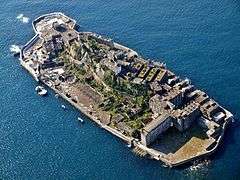
- Chloride (Arizona), USA — A silver mining town (1862-1944), once population 2,000, was largely abandoned once the silver chloride deposits were depleted; just 250 people remain.
- Gagnon and Fire Lake, near Quebec Route 389, Canada - Built to serve mines which closed as iron ore prices collapsed; the villages were abandoned and largely dismantled in 1985. A couple of large silos remain. Schefferville came close to the same fate, but still has a few hundred people - many Aboriginal.
- Gleeson, Courtland, Pearce and Cochise (Arizona), USA — A string of copper mining towns was abandoned once the ore was depleted.
- Gunkanjima (端島 or Hashima, known also as Battleship Island) off Nagasaki, Japan — A former city (once the record holder for highest population density in the world) and mining community has been a ghost town since 1974 as a result of a Japanese coal mining crisis in the 1960s, but remains accessible by organized boat tours.
- Kadykchan, Magadan Oblast, Russian Far East — A coal mining town quickly waned after its mine was closed down due to an accident and the skyrocketing costs as the government subsidies were done away with alongside communism. The final blow to the town was a hot water system failure in what is among the coldest areas on earth. Kadykchan is traversed by the Kolyma Highway, which connects it with other semi-abandoned towns deep inside the taiga.
- Kolmanskop (near Lüderitz), Namibia — A desert town abandoned in 1956 after its diamond field ran out. Its German colonial buildings, now under knee-deep sand, are the destination of daily tours from Lüderitz.
- Ny-Ålesund, Svalbard, Norway — A 1916 coal mining town, which housed 400 people at its peak, was shut down in 1962 after an explosion killed 21. Ny-Ålesund (78.916°N, 11.933°E) reopened in 1968 as an Arctic research base.
- Pyramiden — One of three Soviet-era mining towns on Svalbard; the Svalbard Treaty granted Norway sovereignty but allowed all treaty signatories to exploit natural resources. Abandoned in 1998 as too costly to operate, leaving Barentsburg (Баренцбург) as the only remaining Russian settlement on Svalbard. Reachable seasonally by ship from Longyearbyen in Norway's high Arctic.
- Sego (near Thompson Springs, Utah) USA — A coal-mining town abandoned in the 1950s. A boarding house, company store, and some foundations and dugouts are all that remain.
- Jussarö island south of Raseborg on the southern coast is Finland's only ghost mining town. The rugged and scenic island hosts by design a guest marina ( 59°49,6‘N 23°34,1‘E) on the Hanko-Helsinki southern route.
Railway and highway abandonment
- Amboy (California), USA — created as one in a series of alphabetically-named rail towns at which steam trains once stopped to take on water. The train no longer stops.
- Cisco, near Moab (Utah), USA — old west rail town, a saloon and water-refilling station for the Denver and Rio Grande Western Railroad mentioned in Johnny Cash song "Cisco Clifton's Fillin Station". The town's decline coincided with the demise of the steam locomotive.
- Cooladdi (Queensland), Australia — pre-dated the arrival of the railway, but died after the rails were rerouted away from the town.
- Depot Harbour (Ontario), Canada — Great Lakes cargo port serving a rail line which crossed Algonquin Provincial Park to Ottawa. The rail line fell into disuse as competing railways were consolidated and was abandoned.
- Glenrio (New Mexico and Texas), USA — Former railway town (the tracks are now gone) and Route 66 rest stop (bypassed by a freeway, now I-40). Texola, a rail town on Route 66 just across the border from Texas to Oklahoma, is almost as dead; as of 2010, only three dozen people remained.
- Hackberry (Arizona), USA — An 1875 mining town west of Peach Springs; the silver mine closed in 1919 amid legal infighting between its owners. Route 66 came to town in 1926; Arizona 66 from Kingman to Seligman (82 miles) was bypassed by I-40 on a more direct 69-mile route in the 1970s. Hackberry was abandoned from 1978 to 1992, Valentine and Truxton also became highway ghost towns while Peach Springs was kept marginally alive by the Hualapai nation.
Abandoned military installations
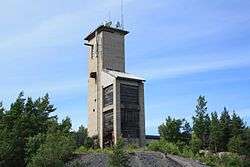
- Jussarö, an island near Raseborg, Finland — Former iron ore mining site used by the army for urban war simulations (1967-2005), then abandoned. A lighthouse still stands on the island.
- Peenemünde, in northeastern Germany near the Polish border — V1 and V2 rockets were built and launched here by the Germans during WW2. The abandoned sites are today an open air museum.
- Skrunda-1 radar base, near Kuldīga, Latvia — Soviet over-the-horizon radar installation, dismantled 1998 and abandoned. Sixty buildings included apartment blocks, a school, barracks and an officers club; effectively, a former village of 5000 people. A private Latvian company Iniciative Europa purchased the site for 170,000 Latvian lats in 2010 but, as of 2012, the property remains abandoned with a lone guard blocking the main entrance to visitors.
Industrial abandonment
- Fordlândia was established as a rubber plantation for the Ford Motor Company in the middle of the Brazilian jungle in 1928. However as the management didn't know anything about tropical agriculture and the indigenous workforce was badly treated (which even led to an uprising in 1930), the project turned into a fiasco pretty quickly. Ford made a new attempt in nearby Belterra (where rubber is still produced); however, the invention of synthetic rubber made Henry Ford's grandson sell everything to the Brazilian government in 1945 for about 1% of what they had invested in the projects over the years. Today you can visit the ruins of the plantation by car or tour from Santarém (Brazil).
- Val-Jalbert, near Roberval (Québec) - Industrial town built around a mechanical pulp and paper mill, powered by a waterfall. Obsolete once pulp for paper was manufactured using chemical (not mechanical) process, now a commercial tourism site with a small modern hydroelectric generating station.
Abandoned resorts
- Arlington (Missouri), opposite Jerome on Gasconade River. Originally served by the Pacific Railroad, Stony Dell Resort was a popular pre-World War 2 Route 66 rest stop in the Ozarks, with a pool fed from underground streams. Portions were destroyed when the highway was realigned and widened, the rest is ruins. The original bridge across Little Piney Creek was removed, forcing traffic to bypass the village on what is now I-44. A few miles northeast, a deteriorating ghost tourist court (John's Modern Cabins, near Vernelle's Motel in Newburg) rests abandoned since the 1970s.
- Elkmont (Tennessee), founded in 1908 by the Little River Lumber Company as a logging town, later a resort with a hotel. When Great Smoky Mountains National Park was created, former cottage owners in Elkmont were initially permitted to lease their properties back. This ended in 1992 as the government refused to renew the leases. The former Wonderland Park Hotel structure collapsed in 2005; some other abandoned buildings survive as the Elkmont Historic District, listed on the National Register of Historic Places.
- Prora in northeastern Germany was projected as a monstrous Baltic Sea resort for 20,000 travellers by the Nazis in the 1930s. Construction was almost finished when the Second World War broke out, but the resort never did open. Part of it was later used as barracks by the East German military. Today a small part of it is an official museum and another part of it has been refurbished and is used as a hotel, but most of the buildings are empty.
- Salton Sea, a shallow expanse of water in the Californian desert accidentally created in 1905 when the Colorado River was diverted to the basin it occupies for irrigation, had a booming tourist trade in the 1950s and '60s in the towns that line its shores. However, it all came to an end in the 1980s as the lake's salinity and pollution levels increased to such an extent that there were massive fish die-offs. The former resorts that surround the lake are now semi-ghost towns; Bombay Beach in particular is (in)famous for its former beachside trailer park with abandoned structures encrusted by salt.
- Yashima, Kagawa Prefecture (屋島) near Takamatsu, Shikoku, Japan. Resort with six hotels, a cable car and a few shops built during a 1980s real estate boom, now abandoned.
Failed economic developments
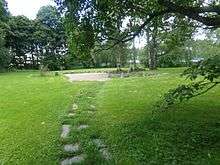
Cities have been built as planned communities and never occupied:
- Kangbashi New Area, Ordos, Inner Mongolia in China was built after 2003 to house a million people as part of China's rapid economic development; by 2010, it had twenty-eight thousand residents. Most of the apartments and shops remain unsold and the town is mostly empty of people.
- A similar China International Trust and Investment Corporation development, Kilamba New City (30km/18miles from Luanda, Angola) was designed to house a half-million people but (as of 2013) had less than a tenth that due to the lack of a middle class able to afford mortgage loans. One school remains open, serving primarily students arriving by bus from other towns.
- Helsinki was first founded by the Swedish king in 1550 at the mouth of Vantaa river. Intended as a competitor to the Hanseatic city of Tallinn, the new city failed to attract inhabitants, and with fires and disease outbreaks the village disappeared in a little more than a century. While Helsinki eventually started growing in the late 18th century at the southern tip of Helsinki peninsula (about 5 kilometers further southwest), a few stones marking the site of Helsinki's first church is the only thing left of the original city.
Stay safe
As these sites are mostly abandoned, their condition is deteriorating rapidly. Roads are often unmaintained. Bridges and structures, if in poor condition, may not be able to bear your weight. The floorboards of abandoned buildings may be rotten and ready to break; buildings may be close to roof collapse. Sites may also be contaminated with anything from broken glass to asbestos.
If a site was abandoned due to man-made environmental disaster, it may still be heavily contaminated. Chornobyl and Fukushima are prime examples, due to currently-active exclusion zones with high levels of radioactive contamination.
See also
- Archaeological sites
- Old towns, historic sites which are still inhabited
- Pioneer villages, living history museums or open-air museums which reconstruct an entire working town
- Architecture and Urbex